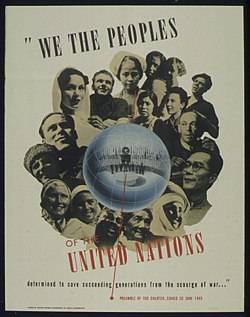 UN Charter | |
| Drafted | 14 August 1941 |
|---|---|
| Signed | 26 June 1945 |
| Location | San Francisco, California, United States |
| Effective | 24 October 1945 |
| Condition | Ratification by China, France, the Soviet Union, the United Kingdom, the United States and by a majority of the other signatory states |
| Parties | 193 |
| Depositary | The Government of the United States of America [1] |
| Languages | Arabic, Chinese, English, French, Russian, and Spanish |
| Full text | |

The Charter of the United Nations, also referred to as the UN Charter, is the foundational treaty of the United Nations. [2] It establishes the purposes, governing structure, and overall framework of the United Nations System, including its principal organs: the Secretariat, General Assembly, Security Council, Economic and Social Council, International Court of Justice, and Trusteeship Council. The UN Charter is an important part of public international law, and is the foundation for much of international law governing the use of force, pacific settlement of disputes, arms control, and other important functions of the maintenance of international peace and security.
Contents
- Summary
- History
- Background
- Drafting and adoption
- Provisions
- Preamble
- Chapter I: Purposes and Principles
- Chapter II: Membership
- Chapter III: Organs
- Chapter IV: The General Assembly
- Chapter V: The Security Council
- Chapter VI: Peaceful Settlement of Disputes
- Chapter VII: Action with respect to Threats to the Peace, Breaches of the Peace, and Acts of Aggression
- Chapter VIII: Regional Arrangements
- Chapter IX: International Economic and Social Co-operation
- Chapter X: The Economic and Social Council
- Chapter XI: Declaration regarding Non-Self-Governing Territories
- Chapter XII: International Trusteeship System
- Chapter XIII: The Trusteeship Council
- Chapter XIV: The International Court of Justice
- Chapter XV: The Secretariat
- Chapter XVI: Miscellaneous Provisions
- Chapter XVII: Transitional Security Arrangements
- Chapter XVIII: Amendments
- Chapter XIX: Ratification and Signature
- Reform
- See also
- Footnotes
- References
- Further reading
- External links
The UN Charter mandates the United Nations and its member states to maintain international peace and security, uphold international law, achieve "higher standards of living" for their citizens, address "economic, social, health, and related problems", and promote "universal respect for, and observance of, human rights and fundamental freedoms for all without distinction as to race, sex, language, or religion". [3] As a charter and constituent treaty, its rules and obligations are binding on all members and supersede those of other treaties. [2] [4]
During the Second World War, the Allies (formally known as the United Nations) agreed to establish a new postwar international organization. [5] Pursuant to this goal, the UN Charter was discussed, prepared, and drafted during the San Francisco Conference that began 25 April 1945, which involved most of the world's sovereign nations. [6] Following two-thirds approval of each part, the final text was unanimously adopted by delegates and opened for signature on 26 June 1945; [7] [8] it was signed in San Francisco, California, United States, by 50 of the 51 original member countries. [7] [Note 1]
The Charter entered into force on 24 October 1945, following ratification by the five permanent members of the United Nations Security Council (United States, China, [Note 2] France, [Note 3] Soviet Union, [Note 4] and United Kingdom) and a majority of the other signatories; this is considered the official starting date of the United Nations, with the first session of the General Assembly, representing all 51 initial members, opening in London the following January. The General Assembly formally recognized 24 October as United Nations Day in 1947, and declared it an official international holiday in 1971. With 193 parties, most countries have now ratified the Charter.




